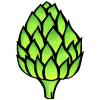Maturity and Quality
The edible bud, composed of a cone of bracts, is harvested at an immature stage and selected for size and compactness. Overdeveloped buds have an open or spreading structure; the bracts have a brownish cast and are tough and stringy; the centers have a fuzzy, pink to purple appearance.
Quality indices are compact and well-formed buds, typical green color, a smooth and uniform stem-cut, freedom from insect damage or handling damage and defects. Artichoke buds should feel heavy for their size. Stems are generally cut 2.5 to 3.8 cm (1 to 1.5 in) below the base.
Postharvest Handling and Storage
- 0°C (32°F)
- Hydrocooling, forced-air cooling, and package-icing are common methods of postharvest cooling of artichokes.
- Storage potential of artichoke is generally less than 21 days as visual and sensory quality deteriorate rapidly.
Temperature
ml CO2/kg·hr
0°C (32°F)
8-225°C
Artichokes have a low sensitivity to exogenous ethylene and therefore it is not considered a factor in postharvest handling and distribution.
- >95% RH
Very low
Controlled or modified atmospheres offer moderate to little benefit to sustaining artichoke quality. Conditions of 2-3% O2 and 3-5% CO2 delay discoloration of bracts and the onset of decay by a few days at temperatures around 5°C (41°F). Atmospheres below 2% O2 may result in internal blackening of artichokes.
Disorders
- Freezing Injury. Freezing injury will be initiated at -1.2°C (29.9°F). Symptoms of light freezing injury are blistering of the cuticle and a bronzing of the outer bracts. This may occur in the field with winter harvested buds and is used in marketing as an index of high quality. More severe freeze injury results in water-soaked bracts and the heart becoming brown to black and gelatinous in appearance over time.
- Bruising and Compression Injury. Very common when attention to careful harvest and handling practices are not followed.
Grey Mold (Botrytis cinerea) and Bacterial Soft Rot (Erwinia carotovora) may be a problem in storage and distribution if optimum temperature conditions are not met. Opportunistic fungi (such as Fusarium spp.) may develop on cut stems or bracts with prolonged low temperature storage.



